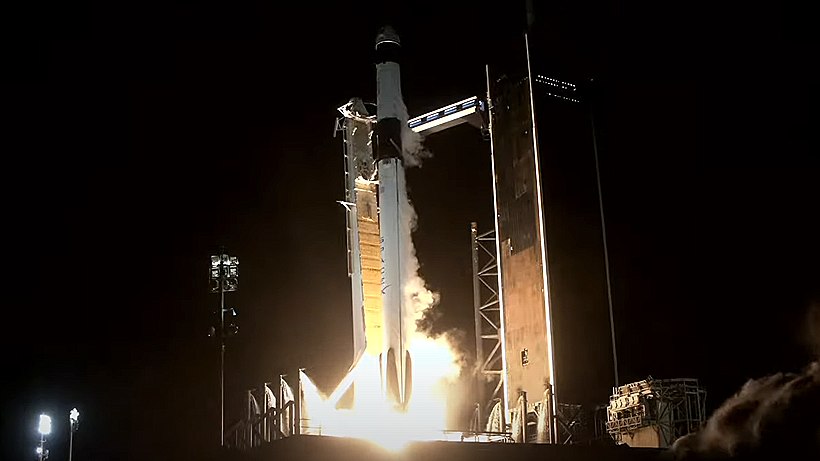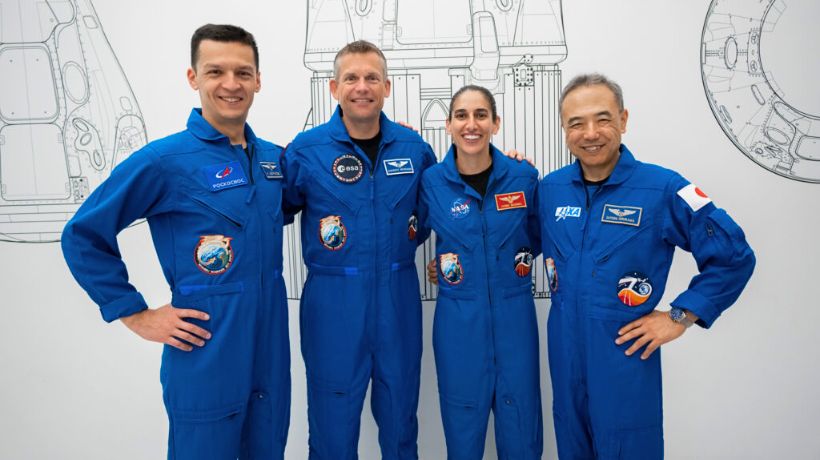
NASA SpaceX Crew 7 mission already launched at 3:27 am EDT on August 26, 2023, from Launchpad 39A at NASA Kennedy Space station in the state of Florida, USA. The crew of four people from four different countries is aboard SpaceX dragon spacecraft, which will go and doc with International Space Station (ISS).
The crew of NASA SpaceX Crew-7 mission consists of following four astronauts.
| Astronaut | Space Agency/Country |
|---|---|
| Andreas Mogensen | European Space Agency (ESA) Denmark |
| Jasmin Moghbeli | National Aeronautics and Space Administration (NASA) United States |
| Konstantin Borisov | Roscosmos Space Agency Russia |
| Satoshi Furukawa | Japan Aerospace Exploration Agency (JAXA) Japan |

NASA SpaceX Crew-7 mission to the ISS is also called the Expedition 70 mission. Mission members are expected to spend time span of about six months at the space station and will return after arrival of next expedition mission to ISS. Similarly, Expedition 69 members, the members of Crew 6 mission, will make a return to earth few days after the Crew 7 docks to the ISS.
Crew 7 mission launch date was advanced many times, however, it was expected to launch in the end of August 2023. So the crew 7 mission launched pretty much on schedule on top of a falcon 9 rocket of SpaceX. Currently the dragon module of the Crew 7 mission is on approach to ISS, it is continuing to go closer and closer looking to dock to ISS.
Crew 7 mission is pretty much a success, as it is only just few hundred meters from the ISS. In an hour or, hopefully it will have successfully docked to the ISS. We will keep you updated after the SpaceX Crew Dragon from the Crew-7 mission docks to the ISS. We will also update you about the return of Crew-6 mission. So make sure to switch on the push notifications from bell icon on bottom right corner of this page.
More about Falcon 9 Rockets of SpaceX
One rocket which SpaceX uses the most for its launches is Falcon 9 rocket. Same rocket is used to launch the NASA SpaceX Crew 7 mission. Falcon 9 is a two stage rocket to send the payloads, human and cargo to lower earth orbit and even beyond. Good thing about Falcon 9 rocket is that its first stage is fully reusable which be used again and again. As it flies to a certain height, then it detaches from the second stage and comes back to land on a pad either on ground or on an unmanned drone ship in the sea, while the second stage continues on the mission.
According to the official information page of falcon 9 rocket it can carry 22800 KG payload to Lower Earth Orbit (LEO), 8300 KG payload to Geostationary Transfer Orbit (GTO) which is also called Geosynchronous orbit. Falcon 9 rocket will also be able to carry maximum payload of 4020 KG to mars. However, that capability of the falcon 9 rocket has yet not been tested in the real world as falcon 9 rocket have not been involved in any mars mission yet.
Falcon 9 rockets use marlin engines which are engineered and developed by SpaceX itself. Marlin engines use the rocket grade Kerosene Oil (RP1) and Liquid Oxygen (LOX) as their fuel. SpaceX have done lots of work on the Marlin engines. After successfully creating and using the first version of Marlin engines, SpaceX improved on design and building blocks in iterations and in turn have also improved the efficiency of engine overtime.
SpaceX’s focus of reusable rockets
According to the founder of SpaceX, Elon Musk, the cost of rocket technology is very high. Specially the fact that until now a rockets have just been discarded after single flight, this increases the overall cost of Space mission very high. Right from the beginning SpaceX focused on reusing the rocket component to maximum extents. Their first focus was on reusing the first stage of different rockets as well reusing any boosters used in a rocket.
In beginning SpaceX faced many failures in this regard and they lost many first stages of rockets while trying to land them back on earth or on drone ships on sea. However, lateron not only SpaceX successfully achieved landing the first stages of rockets but have perfected it to the level that today for almost all the flights of falcon 9, SpaceX successfully lands its first stage. Falcon heavy is another rocket of SpaceX which along with first stage also uses two rocket boosters, so for maximum missions, SpaceX now lands the first stage as well as rocket boosters of Falcon Heavy as well.
For many missions involving delicate payloads like satellites two metal shields are used to protect the payload in the first half of mission, these shields are called fairing halves. They are normally separated and thrown back into the sea after the rocket clears the earth’s atmosphere. SpaceX even tracks these, tries to recover them with the help of ships they have already deployed in sea during a mission. So lots of time they are recovered and used on next missions.
So by recovering and reusing the fairing halves as well as by reusing the first stages and rocket boosters SpaceX saves lots of money. This way they can fund their futures ambitions to go to mars and settle there, as well as they can offer very competitive prices to any private partners looking for rocket companies to deliver their payload (like satellites etc) to earth’s orbits.